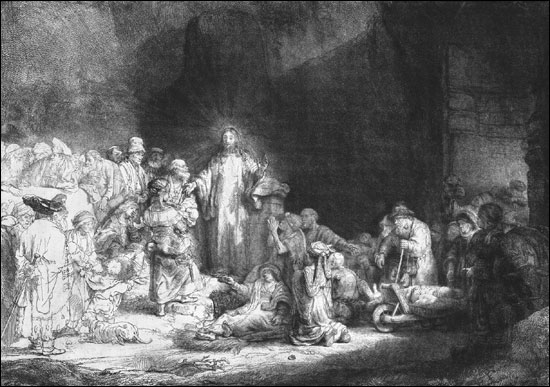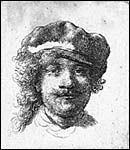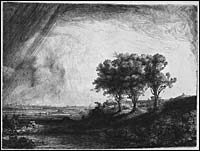The Cabinet cantonal des estampes holds a collection of over 100 etchings by Rembrandt, one of the most remarkable collections held in a Swiss museum. It was started last century by three enlightened amateurs and has been regularly enriched ever since. An impresive selection is shown for the celebration. for the celebration of the 400th anniversary of Rembrandt’s birth. The exhibition invites us to follow a chronological presentation in which the periods of Rembrandt's life reflect the creation of his engraved master pieces
His early years
Born in Leyde on 15 July 1606, Rembrandt Harmensz van Rijn is the ninth child of a miller’s family on the Rhine river - hence the nickname van Rijn. He was the only one among his brothers to have the privilege to follow classic studies. Yet he dropped them to dedicate himself to art and took lessons from various painters in Leyde and Amsterdam. In 1626 he opened a workshop in Leyde and started making engravings, above all portraits of beggars and members of his family, freely sketched on etching varnish.
Illustration REMBRANDT Self-portrait wearing a cap, circa 1634, etching, unique state, 52 x 44.5 mm. Cabinet cantonal des estampes, Vevey (William Cuendet Collection).
Amsterdam and Saskia
In 1637 Rembrandt definitely settles in Amsterdam, first at the home of art dealer Hendrix van Uylenburgh, whose niece Saskia he marries in 1634, then at Sint Anthonies Breestraat where he buys a house. A period of prosperity then begins as he receives various commissions for paintings: Dr.Tulp’s anatomy lesson, Nightwatch. He becomes the portrait artist most in vogue. He has four children with Saskia, of which only the youngest, Titus, born in 1641, survives. In June 1642 Saskia dies at the age of 29 after a long illness. Rembrandt continues to be interested in the study of heads, but he starts working on religious subjects. His etchings are further worked, with a network of lines that is more dense.
The masterpieces
At Saskia's death he employed Geertje Dircx to take care of Titus and she later became his mistress. The relationship deteriorated with time and in 1647 she was replaced by Hendrickje Stoffels. A daughter, Cornelia, was born of this relationship in 1654. This is the period during which Rembrandt engraved his masterpieces: The hundred guilder print, The Three Crosses, and some remarkable landscapes. These were followed by a series of bible and religious subjects, as well as major portraits. Even prior to the discovery of tint techniques such as the black manner or aquatint, he made his network of carvings increasingly dense until he reached his unique velveteen blacks. In his landscapes in particular, he started to engrave directly with the drypoint on copper, resulting in extremely modern, spontaneous prints.
Illustration : REMBRANDT The three trees, 1643, engraving, drypoint and burin, unique state, 209 x 280.5 mm. Cabinet cantonal des estampes, Vevey (Pierre Decker collection).
Bankruptcy, the last years
Burdened by serious financial difficulties, Rembrandt is forced to auction his belongings and to sell his house. In 1660 he moves to the popular neighborhood of Rozengracht. From then on Titus and Hendrickje take care of his business. Following a series of biblical subjects that show his deep, interiorized thinking, Rembrandt carried out some of his most beautiful works, and then ceased all engraving. His last plate is a commissioned portrait dated in 1665. Death haunts him : Hendrickje dies in 1663 and Titus dies prematurely in 1668, shortly before the birth of the artist’s grand daughter, Titia. Rembrandt dies on 4 October 1669
| 









